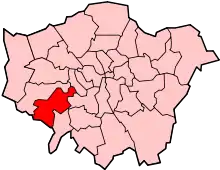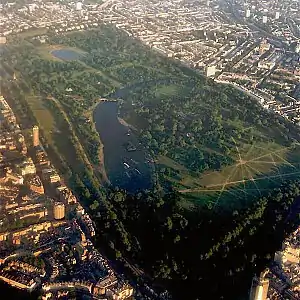Kew Green
Kew Green is a large open space in Kew in west London. Owned by the Crown Estate, it is leased to the London Borough of Richmond upon Thames.[1] It is roughly triangular in shape, and its open grassland, framed with broadleaf trees, extends to about thirty acres. Kew Green is overlooked by a mixture of period townhouses, historic buildings and commercial establishments. In the 1730s, Kew Green was a venue for cricket matches.
| Kew Green | |
|---|---|
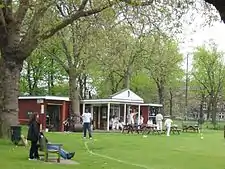 The cricket pavilion on Kew Green | |
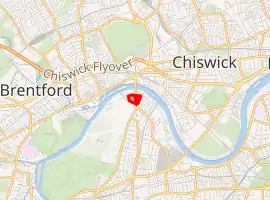
| |
| Type | Village green |
| Location | Kew, London |
| Coordinates | 51.485°N 0.288°W |
| Area | 30 acres |
| Operated by | London Borough of Richmond upon Thames |
| Status | Open all year |
History and description
Most of the older houses in Kew are built round the Green and along the eastern side of the Kew Road looking towards Kew Gardens. The Green itself is a big triangular space. It is mentioned in a Parliamentary Survey of Richmond taken in 1649, and is there described as 'a piece of common or uninclosed ground called Kew Green, lying within the Township of Kew, conteyning about 20 acres.' An 18th-century view, taken from a meadow to the east, shows Kew Bridge on the right, a small irregular lake with an island to the left. A road led to the western point of the Green, where the palace was visible, a windmill behind it; and trees, the trunks engirdled by seats, grew opposite the square-built church which stood isolated on the Green. Some land at the end of the Green was enclosed by George IV, and a meadow east of the bridge was made common land, as part of a design, never carried out, of building a new palace at Kew in place of the Dutch House. In the early 19th century Sir Richard Phillips described the Green as 'a triangular area of about 30 acres bounded by dwelling-houses,' and another description of a slightly later date speaks of the 'well-built houses and noble trees' surrounding it.[2]
Kew Green was in use as a venue for cricket by the 1730s and was used for a match between London and a Middlesex XI in 1732. A women's One Day International between New Zealand and Jamiaca was scheduled to be held on the Green in 1973 as part of the inaugural Women's Cricket World Cup but the match was abandoned without a toss being made. The match would have been the first Women's One Day International match ever played.[3] It is still used for club cricket today as the home of Kew Cricket Club.
Today the eastern and southwestern sides of the Green are residential; the northern side is largely residential, with a few pubs, restaurants, and the Herbarium Library; and a small number of commercial and retail buildings cluster in the southeast corner. To the north of the Green is Kew Bridge, carrying the busy South Circular Road, which in turn runs across the Green, dividing it into a large western part and a smaller eastern part. At the south end is St Anne's Church, Kew's parish church. At the west end of the Green is Elizabeth Gate, one of the two main entrances into Kew Gardens. Near the northeast corner is Kew Pond, originally thought to have been a natural pond fed from a creek of the tidal Thames. During high (spring) tides sluice gates are opened to allow river water to fill the pond via an underground channel. The pond is concreted, rectangular in shape and contains an important reed bed habitat which is vital for conservation and resident water birds. The pond is managed in partnership with the Friends of Kew Pond.[4]
Buildings
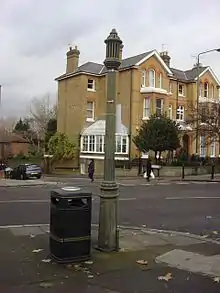
Kew Green is also a street address. The odd-numbered buildings face the west side, and the even-numbered buildings face the east.
On the west side, Numbers 9–11, 17–25, 29–33, 49–51 and 55 Kew Green are all Grade II listed,[5][6][7][8][9][10][11][12][13] as are Numbers 57–73, 77, and 83.[14][15][16][17][18][19][20][21][22][23] On the east side, Numbers 2–4, 18–22, 52–56, 62–64, 90, and 96–106 Kew Green are all Grade II listed.[24][25][26][27][28][29][30][31]
Also Grade II listed are some lamp standards,[32] a Victorian sewer vent,[33] a K6 red telephone box,[34] and the cross-shaped war memorial near the church,[35] all on the west side of Kew Green.
The Coach and Horses public house is at 8, Kew Green. Another public house, the Greyhound, is at 82, Kew Green. 79, Kew Green is also a public house, but has changed its name; for many years it was known as the Rose and Crown, but in 2013 it became the Cricketers. 85, Kew Green was once the King's Arms public house, but it has now become an Italian restaurant.[36]
From 1964 until it folded in 1997, the Caxton Name Plate Manufacturing Company was based at 110, Kew Green. The company's name is still visible on the exterior of the building.[37] At the back of Caxton House facing Westerley Ware is the Victorian mortuary building.
50, Kew Green was the original home of Kew's main primary school, the Queen's Church of England School, founded in 1824 as the King's School (the name of the school changes with the sex of the monarch). The building was rebuilt in 1887. In 1969 the school moved to new premises in Cumberland Road and the Victorian schoolhouse was demolished.[38] To preserve its legacy, there is an embroidery of the original building in the pew cushions of St Anne's Church.
22, Kew Green was the home of the painter Arthur Hughes;[39] and 49, Kew Green was the home of William Jackson Hooker and later of his son Joseph Dalton Hooker, both directors of Kew Gardens, and both now buried in St Anne's churchyard.[40] Both properties have blue plaques.
Gallery
 View of the northern half of Kew Green
View of the northern half of Kew Green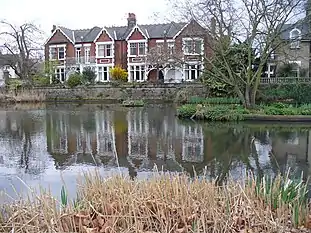 The pond near Kew Green
The pond near Kew Green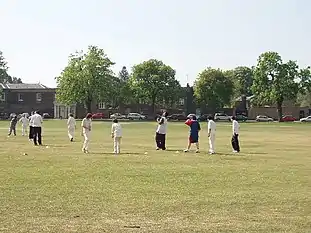 Practising cricket on Kew Green
Practising cricket on Kew Green.jpg.webp) One of the listed houses on the green
One of the listed houses on the green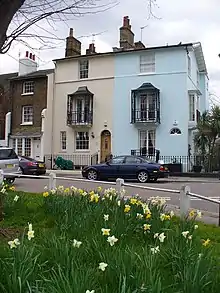 The northeast corner of the green
The northeast corner of the green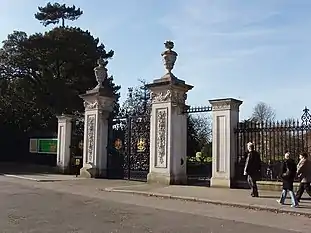 Elizabeth Gate, one of the entrances into Kew Gardens, at the west end of the green
Elizabeth Gate, one of the entrances into Kew Gardens, at the west end of the green
References
- "Kew Green". richmond.gov.uk. Archived from the original on 4 March 2016. Retrieved 7 February 2017.
- "Parishes: Kew". British History. Retrieved 7 February 2017.
- Kew Green, Kew, CricketArchive. Retrieved 9 December 2020. (subscription required)
- "Kew Pond". richmond.gov.uk. Archived from the original on 14 February 2017. Retrieved 13 February 2017.
- Historic England. "9 and 11 Kew Green (1193889)". National Heritage List for England. Retrieved 7 February 2017.
- Historic England. "17 and 19 Kew Green (1065438)". National Heritage List for England. Retrieved 7 February 2017.
- Historic England. "21 Kew Green (1357712)". National Heritage List for England. Retrieved 7 February 2017.
- Historic England. "23 and 25 Kew Green (1285937)". National Heritage List for England. Retrieved 7 February 2017.
- Historic England. "29 and 31 Kew Green (1065395)". National Heritage List for England. Retrieved 7 February 2017.
- Historic England. "King's Cottage, 33 Kew Green (1357731)". National Heritage List for England. Retrieved 7 February 2017.
- Historic England. "49 Kew Green (1357732)". National Heritage List for England. Retrieved 7 February 2017.
- Historic England. "Royal Cottage, 51 Kew Green (1065398)". National Heritage List for England. Retrieved 7 February 2017.
- Historic England. "Herbarium House, 53 Kew Green (1357733)". National Heritage List for England. Retrieved 7 February 2017.
- Historic England. "Hanover House, 57 Kew Green (1065400)". National Heritage List for England. Retrieved 8 February 2017.
- Historic England. "59 and 61 Kew Green (1065401)". National Heritage List for England. Retrieved 7 February 2017.
- Historic England. "63 Kew Green (1065402)". National Heritage List for England. Retrieved 7 February 2017.
- Historic England. "Warden House, 65 Kew Green (1065403)". National Heritage List for England. Retrieved 7 February 2017.
- Historic England. "White House, 67 Kew Green (1065404)". National Heritage List for England. Retrieved 7 February 2017.
- Historic England. "Ada Villa, 69 Kew Green (1193975)". National Heritage List for England. Retrieved 7 February 2017.
- Historic England. "71 Kew Green (1065405)". National Heritage List for England. Retrieved 7 February 2017.
- Historic England. "Danebury House, 73 Kew Green (1193981)". National Heritage List for England. Retrieved 7 February 2017.
- Historic England. "77 Kew Green (1065406)". National Heritage List for England. Retrieved 7 February 2017.
- Historic England. "Capel House, 83 Kew Green (1357734)". National Heritage List for England. Retrieved 7 February 2017.
- Historic England. "2-4 Kew Green (1065409)". National Heritage List for England. Retrieved 7 February 2017.
- Historic England. "18 Kew Green (1194119)". National Heritage List for England. Retrieved 7 February 2017.
- Historic England. "20 Kew Green (1357736)". National Heritage List for England. Retrieved 7 February 2017.
- Historic England. "22 Kew Green (1065410)". National Heritage List for England. Retrieved 7 February 2017.
- Historic England. "52-56, Kew Green (1194130)". National Heritage List for England. Retrieved 8 February 2017.
- Historic England. "62 and 64 Kew Green (1357697)". National Heritage List for England. Retrieved 8 February 2017.
- Historic England. "90 and 96 Kew Green (1194151)". National Heritage List for England. Retrieved 7 February 2017.
- Historic England. "98-106 Kew Green (1065411)". National Heritage List for England. Retrieved 7 February 2017.
- Historic England. "Lamp standards (1194067)". National Heritage List for England. Retrieved 7 February 2017.
- Historic England. "Sewer vent (1065408)". National Heritage List for England. Retrieved 7 February 2017.
- Historic England. "K6 Telephone Kiosk (1254349)". National Heritage List for England. Retrieved 7 February 2017.
- Historic England. "Kew War Memorial (1425802)". National Heritage List for England. Retrieved 8 February 2017.
- "King's Arms, Kew, Surrey". Closed Pubs. Retrieved 7 February 2017.
- "Caxton Name Plate Manufacturing Company Limited". Company Check. Retrieved 7 February 2017.
- Cassidy, plate 62.
- "Arthur Hughes". Blue Plaque Places. Retrieved 13 February 2017.
- "William Jackson Hooker and Joseph Dalton Hooker". Blue Plaque Places. Retrieved 13 February 2017.
Further reading
- The Streets of Richmond and Kew (Third ed.). Richmond Local History Society. 2019. 140 pages. ISBN 978-1912-314010.
- Moses. John: "Kew Green", The Kew Society, 2020
Bibliography
- Cassidy, G. E. (1982). Kew As It Was. Nelson: Hendon Publishing Co. Ltd. ISBN 9780860670742.
